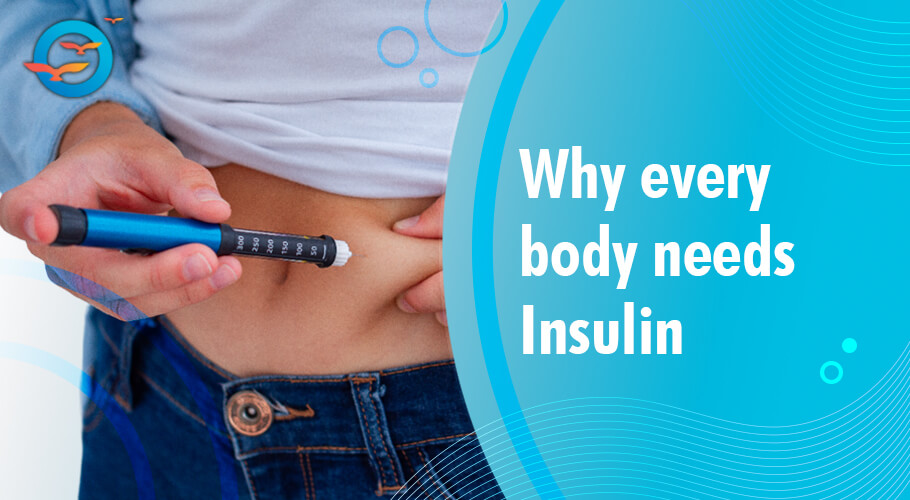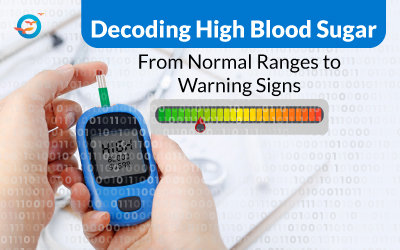Diabetic: Insulin and its importance

Every time you consume food, the body converts the carbohydrates in the food into glucose. This glucose is essential for the creation of energy. But for this to happen the glucose needs to reach the cells in the body. Insulin is the key that opens the cells and lets the glucose in. When glucose levels in the blood rise, beta cells in the pancreas secrete insulin into the bloodstream, from where the glucose is transported into the cells and the level of glucose in the blood drops.
However when we overeat or eat high carbohydrate foods, there is a certain quantity of glucose left in the blood after the cells have been filled, this is then converted into fat by the insulin—this is actually a reserve of energy.
This is also why diabetics tend to be overweight. A clear understanding of insulin function is the first step toward controlling and/or reversing diabetes. To know the Role of Insulin in the body, click the image below
Insulin. Is it a hormone or an enzyme, and why does it matter?
Given that insulin is a chemical that activates a biological function, it is natural to wonder whether it is an enzyme or a hormone. Whereas both enzymes and hormones are chemicals and both are needed to activate biological functions, there is a critical difference between the two. Enzymes are basically catalysts, while hormones are like messengers who stimulate certain reactions in the body.
Thus, insulin is a hormone and not an enzyme. Its presence in the blood enables glucose to enter the body’s cells, where it is used to create energy.
Insulin is considered an anabolic hormone—in fact, it is the main anabolic hormone in the body—as it is needed to synthesize protein. This also means that low insulin levels are responsible for catabolic reactions in the body, i.e. breakdown of tissue, including stored body fat. This is also why fasting has such a strong effect on fat breakdown.
To understand more about this essential hormone, click the image below
Causes of insulin resistance
Sometimes the insulin produced in the body stops functioning effectively. I.e. it is unable to open cells for glucose in the blood to enter. This leads to an accumulation of glucose in the blood, which is what we call High Blood Sugar. Over time, if ignored or inadequately treated this will result in diabetes and all the ills that diabetes brings, including high BP, kidney disorders, cardiac damage, etc.
As we have seen, insulin is like a key that opens cells allowing glucose to enter. It is the presence of glucose in the blood that itself triggers the secretion of insulin from the pancreas. Unfortunately sometimes the pancreas does not produce sufficient insulin, or the insulin is unable to open up the cells to allow glucose to enter. This is medically described as insulin resistance.
The causes could be dietary, lack of physical activity, or accumulation of stress. Eventually it results in diabetes. This is also why it is known as a lifestyle disorder. The good news is that diabetes can not only be managed properly; it can also be completely reversed, as we, at FFD, have proven tens of thousands of times over.
To fully understand the science of diabetes reversal, it is advisable to understand the root causes of insulin resistance, which we have detailed in our article, To read the article click the image below
Insulin types and their uses
Sometimes, as in the case of Type 1 diabetes, it is not possible to manage the condition with diet, exercise and stress management, and even oral medication. In these cases, external administration of insulin is required. However, as we know, blood sugar management is a 24x7 affair. In other words, the body needs to maintain normal glucose levels day and night, during meals, to do this efficiently the body needs insulin for long-term needs as well as when there is a large intake of glucose, i.e. mealtimes.
To cover these needs, insulin-dependent diabetics use different types of insulin, including short-acting, intermediate- long- and ultra long-acting insulins. These types are differentiated by the time it takes to act and the duration of the action. There are many criteria governing the use of each, and several precautions one should take to use the different types of insulin safely.
These are covered in detail in our article, click the image below
Calculating insulin dosage: insulin: carb ratio
When we consume carbohydrates, the body converts it into glucose, which is absorbed into the bloodstream. The presence of glucose in the blood triggers the release of insulin by the pancreas. Sometimes the insulin released by the pancreas is not able to function properly—a condition known as insulin resistance—leading to a rise in blood glucose. To overcome this problem, diabetics need external insulin. However, excess insulin converts glucose into fat, which in turn worsens insulin resistance. This close association between glucose and insulin is the reason diabetics using insulin must calculate their insulin dose as accurately as possible.
Our article: Insulin to Carbohydrate Ratio—how much insulin do you really need? will help you understand the factors behind the ratio and how to calculate your insulin dose correctly for more effective management of blood glucose levels.
Insulin overdose—reasons, symptoms, and treatment
Insulin dosages depend on a number of factors, such as the current blood sugar condition of the patient, how physically active they are, the quantity of carbs to be consumed, the type of insulin, and even the time of day. All these factors play a role in determining how much insulin needs to be administered.
Despite all precautions, it is possible that there could be a miscalculation. For instance, the meal could be delayed; physical activity doesn’t take place; etc. If these situations occur there will be an overdose of insulin and the patient will go into hypoglycemia (low blood sugar.)
When this happens the patient needs immediate treatment, as hypoglycemia is a potentially life-threatening condition. The symptoms can vary from mild to severe and must be treated accordingly. Insulin overdose is a fact that all diabetics must live with, but with a few precautions, there is no need to worry.
These include carrying an identity card that declares your condition and informs the reader (usually a co-worker or bystander) about recommended first aid. The diabetic should also carry something sweet, like glucose gel or tablet or candy that they can consume for immediate relief. After the symptoms have subsided, it is just as important to visit a doctor for a more thorough check-up.
Our article: Insulin overdose—reasons, symptoms, and treatment shares all the information you need to be aware of. You can read it by clicking the image below
Hypoglycemia—what is it, and how to deal with it.
There is not gainsaying it, diabetes is literally a lifesaver for millions of people suffering from diabetes. And considering the fact that the biggest indication of diabetes is high blood sugar, the opposite—low blood sugar—should be good, right? Wrong! Low blood sugar—which is known as hypoglycemia is a potential killer. Worse, it strikes suddenly and silently, and if the right help doesn’t come in time, it can be fatal. Understanding the risks, symptoms, and treatment is imperative for diabetics and their caregivers, so it can be identified, and addressed quickly if it occurs, and most of all, knowing how it can be prevented.
Our article: Care to be taken while on insulin--understanding hypoglycemia is an essential read for every diabetic.
You can read it by clicking the image below
What you should know about Insulin Glargine
In some cases, Type 1 diabetes, for instance, the body just doesn’t produce insulin or produces insufficient. In these cases, insulin needs to be administered externally. Now, blood sugar needs to be managed 24x7. Usually, the body does this automatically by secreting insulin when blood sugar is high, and stopping release when it subsides. When you eat food, the body automatically releases extra insulin to handle the extra carbs. However, when one is dependent on external insulin, this doesn’t happen automatically. In these situations, the body needs longer-acting insulin, which is supplemented by short-acting insulin types.
Insulin Glargine is such a long-acting dose. Because it is a basal dose, it needs to be supplemented with a bolus—or quick-acting insulin—dose.
To understand the do’s and don’ts about Insulin Glargine and how to use it safely and properly, read our article: Important Information about Insulin Glargine, Click the image below
Human regular insulin—what is it, and how to use it
Insulin, a hormone made in your pancreas, has one fundamental function: to move glucose from your blood to your body’s cells.
Sometimes the insulin made by the pancreas doesn’t function efficiently, i.e. it is unable to allow access of the glucose in the blood into the body’s cells. When this happens glucose levels build up in the blood, eventually causing diabetes, and sometimes requiring external administration of insulin.
Sometimes, a doctor may prescribe Insulin regular human injections to manage your blood sugar levels.
Insulin Regular human is a short-acting insulin type that is used in conjunction with a correct diet and proper exercise to keep blood sugar levels in the normal range in people suffering from diabetes—both, type 1 & type 2.
Insulin regular human is artificial insulin but similar in composition to the insulin made in the human pancreas, hence the name. And it has the same response to glucose as naturally produced insulin, which is why it is so effective in controlling blood sugar levels (BSL) and preventing diabetes complications.
There are several factors that govern proper usage of human regular insulin injection, but for easier assimilation, we have condensed it in our article: Ten things every user ought to know about insulin regular human injection usage, Click the below image to read more
You can improve insulin resistance
Insulin resistance is the root cause of a number of so-called lifestyle diseases, including diabetes, hypertension, heart disorders, high cholesterol, PCOD/S, kidney damage, and more. Unfortunately for a long time, the medical establishment held the view that the condition was permanent, requiring lifelong medication and treatment.
However, we, at FFD, have conclusively proven that not only can the condition be improved, medicines can be totally stopped and the reversal sustained. We have, to date, helped over 12,000 people across the world successfully reverse their diabetes. Many of our participants were not just heavily diabetic but also suffering from a host of other health complications. Some couldn’t even walk properly, many are now marathoners, cyclists, and yogis.
Our four protocols (diet-exercise-inner transformation-medical) are structured in a manner that guides our participants through a step-by-step phase-wise reversal program. Each participant is assigned a dedicated team comprising a doctor, diet expert, fitness expert, and inner transformation expert. At the end of the day, it all boils down to bringing about a behavioral change, and our article: Ten ways to improve insulin resistance will show you how it can be done, safely.
Start your "Diabetes Reversal" journey with us by participating in our Discover Reversal Session. It is the introductory session of our annual diabetes reversal program which we call a Holistic Transformation Program conducted by Dr. Pramod Tripathi himself. Enroll in the upcoming online session now to learn how you can also reverse your Diabetes.

